Brookfield Farm has been selling honey, honey products, furniture and fiber at Farmers’ Markets in Seattle and Bellingham, Washington for over a decade. Over those years, we came to realize that there were definite “needs” for us to be vendors at the Farmers’ Markets. This is not about canopies, weights, heaters, and, of course, handcrafted folding wooden vending tables with no metal hinges that fold to 3 inches wide, although they are good to have. This is about what we see as even more basic needs. (If you’re wondering what and where we sell, scroll down to the end of this entry.)
FARMERS’ MARKET VENDORS NEED:
1) Lots of foot traffic: you need lots of people to get many purchasers. So a nice, small market may be fun, but probably will not generate good, steady revenue.
2) A market in an area that can afford your product.
If it’s a luxury (i.e. honey infusions) young urban professionals may be more inclined to purchase it than a working couples with families. So, two markets in the same area can be quite different. Try to find out about the buyers who come to the market – visit it before you sign up, watch the buyers, and look at the neighborhood.
3) More than one Farmers’ Market per week. More markets give you a better shot at a good income. Finding two or more markets can be difficult in the winter when many shut down. Often the “anything goes” markets stay open year round. If you are traveling a good distance to one market, check to see if there is one near-by on the day before or after your market. That way the gas and vehicle wear and tear are split between two or more markets. Yes, you will have to find a place to spend the night.
4) Once you start selling at the market, keep going even if you’re not making your booth fee. Within reason, of course. Often new vendors turn up, don’t sell much, and don’t come back. Buyers often have to see you, poke at the goods, and then see you again, before they’ll think of buying. My rule of thumb is eight market days at one market. If we’ve not done well, we pull out. Yes, it’s pricy, but so is a brick and mortar store.
5) Know your product. People will want to talk to you about it. In part because they are interested, some because they want to know if you’re “real”. Don’t be offended when they ask: do you make/grow this? So many things are not made/grown by vendors.
6) Do something while you’re at market (no, reading a book doesn’t count).
My husband works on the furniture he makes, honing the wood to the perfect curve. I don’t have that skill, but I often patch clothes. OK, sounds silly, right? But most people in our market areas don’t sew, and those that do will stop and chat. A vendor we know knits, she sells jewelry, and now her knitting as well. We vendors are part of the “show”, if you can draw them in to watch you, they might buy your product. I once wired bee frames while selling my husband’s furniture. It got a crowd.
7) Be adaptable. Farmer’s markets are a great place to test your product line. Are your jars the right size? Are the flavors popular? Is the table the right height? People will let you know; listen, judiciously, to their comments. I’ve discontinued 2 styles of infused honeys, because they didn’t sell (I love them, others don’t), and added 2 new styles for a holiday theme that went over so well I continue to retail and wholesale those.
8) Stick to your prices. Many people will try to get you to lower your price. “It’s cheaper [somewhere else]”. Our response is “that’s interesting”. “What if I buy 2?” they’ll ask. We usually total the two prices for them and smile. Don’t be offended; in many cultures this process is normal. But stick to your prices.
9) Place your prices at about the same as vendors selling similar items. You can check this out by going to other markets and looking around. You can go higher, but try not to go lower. If we all try to undercut each other, then soon no one will make any money.
10) Remember to factor your gas, wear-and-tear on your vehicle, the booth fee and market membership fee into your retail price along with the cost of your materials and your time.
11) Accept the reasonable idea that you might not get into a market where someone else is already selling what you sell. If you get too many honey vendors at one market you soon have a market with no honey vendors because no one can make their booth fee.
12) Fellow vendors are “family”. Be friendly to other vendors.
We should all be friendly, but this is also practical: the vendor next to you can
watch your table/booth when you have to take a break. Trade with other vendors. Base your trade on retail prices. We have lovely pure maple syrup from a fellow vendor. He has two of my husband’s fabulous tables on which he puts his products.
13) Keep smiling. Most people are nice, some can be a trial. Be polite even if you want to scream.
14) Make a website. Update it regularly and always do an “about us” page and a “contact us” page – let folks know when and where they can find your products. You can often get a free template with your internet service provider, or go to wordpress.com and start a blog. Which leads us to:
15) Do a blog (free at wordpress.com). Make a Facebook page, and then make your business Facebook Page (must have the first for the second). Twitter. It’s all free, but takes time. Post on your blog, facebook, and twitter pages. I do it once a week. Make the posts interesting – something about your bees, herbs, craft, whatever you do and sell, even if it’s a review of an interesting article you read, with a link to the article.
Those are the fundamental “needs” we have discovered over the last decade. It’s a lot of work. And there are good weeks and dismal weeks. But, for me, my husband and for all the vendors who have become our friends over the years it’s a wonderful way of life. My husband says he “runs away to join the circus” when he goes to market. For me, I get to spend my day talking about bees, beekeeping, and honey. It’s a great way to make a living.
BACKGROUND:
What We Sell:
These days we sell our raw (unfiltered, unheated) honey
from hives with no chemicals and no antibiotics; our raw honey infusions (herbs and flowers); organic vinegars infused with raw honey; beeswax salves and lip balms from our chemical-free, antibiotic-free hives, honey from other independent Washington beekeepers, and handcrafted folding and stackable furniture based on historical designs. My husband is the woodworker, not me.
We started out selling yarn and roving from our flock of sheep and cashmere goats, and my husband’s furniture. I joke that I gave up the sheep and shearing because shearing hurt my back, and then I became a beekeeper (all beekeepers are now laughing). At least a bee has never kicked me in the eye while I was shearing it. It’s true. It was scary because I’m also a photographer.
Where We Sell:
If you’re in Seattle, you can visit us year round at Seattle’s Sunday Fremont Market. In the summer we’ll also be at Seattle’s Georgetown Market, and possibly other venues that I’ll post over on our facebook page.
That’s about it for this week from Brookfield Farm Bees and Honey in Maple Falls, Washington. The weather’s still cold and snowy and the bees are all in cluster, but the alders and salmonberries are starting to push out leaf buds, so spring is happily on the way.

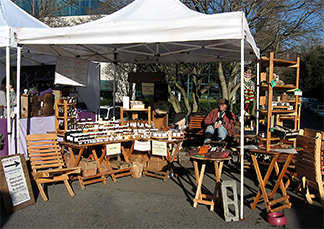
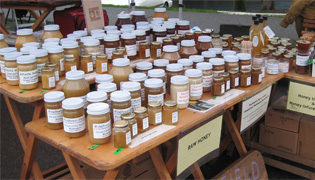
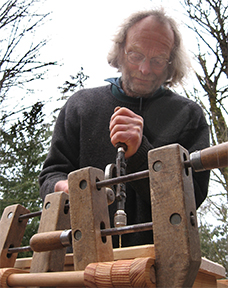
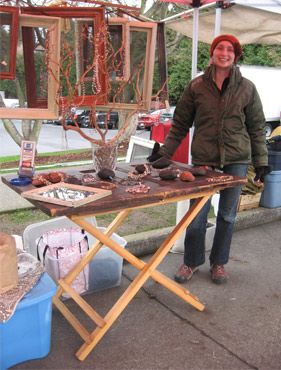
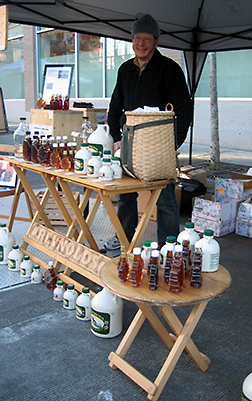
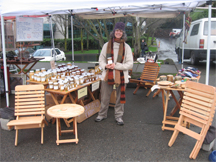
2 Responses to Selling At Farmers’ Markets – A Few Necessities